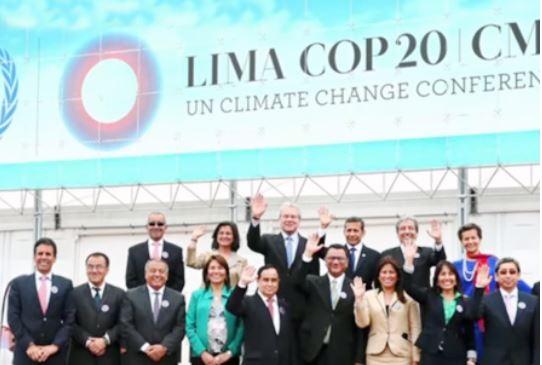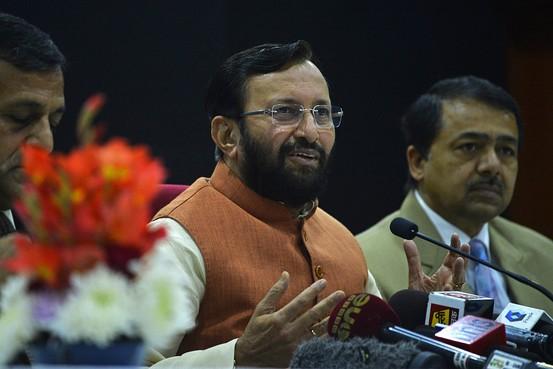Lima climate summit: bad signs for Paris 2015
Anyone following the climate negotiations, especially since the disastrous pattern set at Copenhagen in 2009 and even more so given the tepid progress made since the wishy-washy Durban summit in 2011, could have seen it coming. There were low expectations from the Lima Conference of Parties (COP 20) to begin with and, true to form, the summit ended with a whimper of a Statement, low on ambition on all fronts, emissions reduction, finance and technology, but full of statements with dark portents for the future.

The Lima COP was expected to come up with an outline or building blocks of the Agreement to be clinched next winter in Paris. The recent US-China agreement had also been hyped as a sign of a new momentum towards a Paris deal with ambitious emissions reductions commitments by important countries. But the Lima summit revealed no sense of urgency or purpose. On the main agenda, commitments to emissions reduction by developed countries, particularly the US and Japan, not to mention Australia and Canada, were low key. Large developing countries too, notably China and India, seem to have gone along with this, bar a few protestations here and there, since this also took pressure off them. The former in any case had already announced bilaterally with the US their respective national emission reduction targets.
In what has now become a familiar and depressing pattern, the Summit meandered listlessly without substantive progress and then went into panic-driven overdrive on the penultimate day, delegations postponing return flights and, in the last 24 hours, hammering out a last-minute “compromise” statement which the hosts and the steering UN officials hailed as a victory. As with all such compromise statements, and who can forget Copenhagen, every major country or bloc claimed they had achieved the best under bad circumstances. Developed and large developing countries, the US and EU on the one hand, China and India on the other, all claimed that the outcome was broadly satisfactory from their point of view! However many other developing countries such as Malaysia, poor island nations such as the Marshall Islands and least developed countries such as DR Congo were all extremely unhappy at the outcome, saying it had crossed their major red lines. Several European countries too expressed their frustration that the processed seemed to be leading to agreement around the least common denominator!
Many analysts have parsed the final 6-page outcome document “Lima Call for Climate Action” and have pointed to different phrases that could justify these apparently divergent claims. However, in the considered opinion of this writer, this piecemeal reading of the Lima Call misses the wood for the trees. In fact, the Lima Call has closely followed the trajectory set in Copenhagen and cemented in Durban, and, for all practical purposes, more or less laid the foundation for the post-2020 agreement to be decided at Paris next year in both content and process. The trend of apparently dilatory discussions for most of the summit followed by last-minute compromise is very likely to be repeated in Paris. If so, the balance of benefit will certainly lie with those who have done their homework, and come with a goal and game plan, namely the US and its developed country allies. Needless to say, this will have dangerous consequences for climate change and its impact on developing countries and the world’s poor in general.
Weak emissions reduction: IPCC’s recent 5th Assessment Report (IPCC/AR5) released in three parts between June and September 2014 had underscored how close the world is to missing the small window of opportunity to halt the rise, and then significantly reduce, global emissions so as to moderate climate change and keep surface temperature rise below 2 degrees Celsius, beyond which lies possibly irreversible climate change causing immense damage especially to poor developing countries, island populations and coastal regions. IPCC/AR5 estimates that this would require 40-70 percent reduction of global greenhouse gas (GHG) emission flows from 2010 levels by 2050 and zero or negative (meaning more absorption in forest and ocean “sinks” than emission) GHG emissions by 2100. Countries would also have to move to increase low-carbon energy production (including hydro and nuclear) from the present 30% of total energy production to around 80% or more by 2050 and Zero fossil fuel energy by 2100. Delays in reducing emissions significantly by 2030 will compel much deeper and more painful cuts during 2030-2050.
IPCC/AR5 and several other major studies have analysed that what is on the table in the form of pledges from Cancun, Durban and after, broadly for the period 2020-2030, is woefully short of these targets. Lima has made no meaningful advance beyond this except for a vague statement that each nation’s pledge or “intended nationally determined contribution” (INDC) in climate negotiations parlance, to be submitted to the UNFCCC between March and end-September 2015 “will represent a progression beyond the current undertaking of that Party.” If these low-ambition trends persist through to Paris, people of the world especially the poor are staring at 3-4 degrees C rise in global average surface temperatures with accompanying dire consequences of reduced food production, increase in vector-borne diseases, more extreme weather events.
Two aspects are noteworthy and need some discussion.
First, the solidification in the Lima Call of the architecture of “bottom-up” pledges first enunciated at Copenhagen, which is now almost certain to be formalized in Paris next year. And second, which flows from the voluntary nature of the first, is the virtual dismantling of the firewall between developed and developing countries that had been a centre-piece of the earlier emissions control regime under the Kyoto Protocol and its cornerstone principle of “common but differentiated responsibility” between these groups of nations.
Addressing adequacy: The Lima Call thankfully at least acknowledges “with grave concern” that there is a “significant gap” between these pledges and the stated goal of keeping temperature rise below 2 degrees C, a structural problem with the “bottom-up” architecture. A “pledge and review” system, if honestly implemented, could have tackled, in howsoever unsatisfactory a manner, the issue of how to deal with any gap between the sum of pledges and the emissions reduction required to ensure staying within the 2 degrees C limit, but unfortunately the entire negotiations till now have focused only on pledges with no mention of review.
China, India and several other developing countries were adamant that the issue of “adequacy” (in negotiations jargon) of these pledges should not be addressed in any form since this would violate the sovereignty of nations. In any case, they argued, pledges by developing countries should be out of bounds for any kind of external scrutiny since, unlike with developed countries, these are made not out of any obligation but on a purely voluntary basis and are also not binding. Unfortunately, this stand of playing down adequacy also let the developed countries such as the US off the hook.
Under EU pressure, though, and contrary to Indian and Chinese claims that their views prevailed at Lima, the Lima Call does contain a decision that the UNFCCC Secretariat would “prepare by 1 November 2015 a synthesis report on the aggregate effect of the intended nationally determined contributions communicated by Parties by 1 October 2015.” The moot question is what will happen if the examination shows inadequacy of the sum of the pledges? Would there be a requirement that countries revise their pledges upwards until the sum of pledges pass the adequacy test? And would developed countries stay within their low-ambition pledges and pressurize developing countries to increase their pledges and thus take on a greater share of the burden of emissions reduction? If this were to be followed, then the “bottom-up” approach could be reconciled with the “top-down” need to meet the 2 degrees C goal.
Whether this will happen or not is not clear from the Lima Call.
The Lima Call also lays down a quite detailed structure for submitting INDCs “in order to facilitate clarity, transparency and understanding,” a favourite phrase of the developed nations at Lima, which “may include” (as against “should include” in an earlier draft, the phrasing changed at the instance of China) “quantifiable information on the reference point (including base year), time frames, scope and coverage, planning processes, assumptions and methodological approaches… and how the Party considers [these to be] fair and ambitious.”
Will India (and China) follow the above guidelines? Would they subject the INDCs of the US and other developed countries to rigorous examination of adequacy? Would it not have been better for India and other developing countries to take the lead on emphasizing adequacy and put the developed countries under pressure, rather than defensively avoid the issue of adequacy and let the industrialised nations off the hook?
Firewall dismantled: The Lima Call more or less completes the dismantling of the Kyoto architecture which erected a firewall between developed and developing countries. After considerable battling, the Call does contain a token mention of “common but differentiated responsibilities and respective capabilities” (CBDR&RC) but with a significant rider, adding “in light of different national circumstances” to the standard phrase, thus ensuring that the BASIC nations, for instance, can be placed on a different footing from other developing countries.
On the other end of the “differentiation” scale, the Lima Call shows that developed countries have managed to dilute all their obligations on financing and technology transfer. Developing countries, especially the Africa Group, Small Island Developing States (SIDS) and the LDCs, finally managed to get “loss and damage” (to compensate the poorest nations for damage done beyond the capacity of adaptation measures) included in the Lima document. India, and some other developing countries, have been proclaiming victory about having got adaptation forcefully included in the Lima statement which speaks of the final agreement in Paris addressing, in a balanced manner, “mitigation, adaptation, finance, technology development and transfer, and capacity-building, and transparency of action and support.”
However, it is not clear if this is a victory in any sense. If mitigation is not addressed on priority, and temperature rise reaches 3-4 degrees C, then little would be gained by progress on any other front. And, in any case, developed countries made no additional financial pledges to cover any of these other issues, with only $10 billion having been pledged compared to the estimated $100 billion required. If this small amount is now going to be spread over adaptation, loss and damage, technology transfer, then it means little and would suggest that the developed countries have managed to escape their collective responsibility for having brought about the biggest crisis humanity has faced.
It is a foregone conclusion that the architecture emerging from Paris would be along the above lines. The firewall has well and truly been breached.
India’s position: In light of the above, the declaration of India’s Minister for Environment & Climate Change, Prakash Javdekar said that “we got what we wanted” is puzzling indeed. People the world over want an urgent, effective, science-based and equitable agreement to a global problem on the verge of getting out of control. India is in a region that is among the top-10 most regions in the world most affected by climate change, and it is in India’s vital national interests to secure such a global agreement.

Clearly, that is not what Lima delivered, but the Honourable Minister does not seem displeased. Maybe that is not what the Minister, who went with a brief from the Union Cabinet, wanted out of Lima. The official Indian delegation seems to have adopted its usual defensive approach, not focusing on the strategic global and national goals, but spending all its energy warding off perceived threats when a simple and firm “NO” would have done. No pro-active steps, no ideas, no pressure put on the developed countries and claiming victory or satisfaction when there is none.
It is said India is getting ready to announce an outline of its emissions control goals and a broader INDC quite soon. Perhaps some kind of Joint Statement with the US will be announced when President Obama visits India as Chief Guest at the Republic Day celebrations. It is understood that the US had insisted on this before confirming the Obama visit. Maybe India will take the easy way out, not do any extensive homework but adopt a “China plus 10 years, China minus 10 percent” approach, similar to its announcement of reducing emissions intensity by 25% by 2025 compared to China’s 40% pledge before Copenhagen. A real pity that India, under the BJP dispensation too as with the previous NDA government, does not see fit to have wide ranging consultations with the Indian people to formulate a low-carbon development strategy as well as an international negotiations stance, but is happy to do so at US instance.
Disclaimer: The views expressed here are the author's personal views, and do not necessarily represent the views of Newsclick
Get the latest reports & analysis with people's perspective on Protests, movements & deep analytical videos, discussions of the current affairs in your Telegram app. Subscribe to NewsClick's Telegram channel & get Real-Time updates on stories, as they get published on our website.























